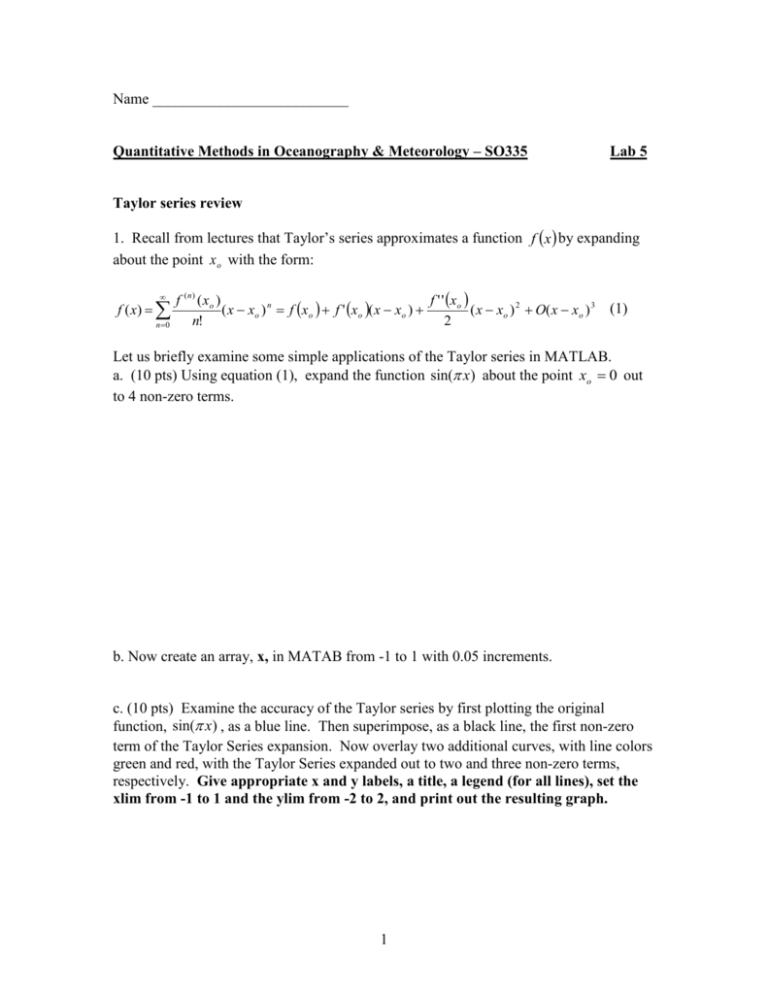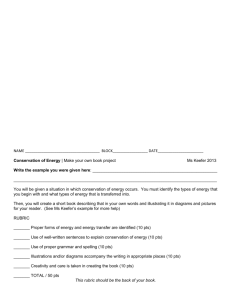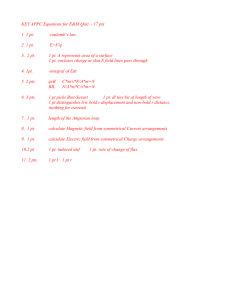Statistics --
advertisement

Name __________________________ Quantitative Methods in Oceanography & Meteorology – SO335 Lab 5 Taylor series review 1. Recall from lectures that Taylor’s series approximates a function f x by expanding about the point x o with the form: f ( x) n 0 f ( n ) ( xo ) f ' ' xo ( x xo ) n f xo f ' xo ( x xo ) ( x x o ) 2 O( x x o ) 3 n! 2 (1) Let us briefly examine some simple applications of the Taylor series in MATLAB. a. (10 pts) Using equation (1), expand the function sin( x) about the point xo 0 out to 4 non-zero terms. b. Now create an array, x, in MATAB from -1 to 1 with 0.05 increments. c. (10 pts) Examine the accuracy of the Taylor series by first plotting the original function, sin( x) , as a blue line. Then superimpose, as a black line, the first non-zero term of the Taylor Series expansion. Now overlay two additional curves, with line colors green and red, with the Taylor Series expanded out to two and three non-zero terms, respectively. Give appropriate x and y labels, a title, a legend (for all lines), set the xlim from -1 to 1 and the ylim from -2 to 2, and print out the resulting graph. 1 d. (5 pts). What do you notice about the accuracy of the function expanded out to one term? What about when the function is expanded to three non-zero terms? About how far out from the origin is the expansion accurate? Based on your observations, what properties of the Taylor series expansion determine its accuracy? 3. Mass Conservation – Recall from class that Gauss’ Theorem allows us to express surface area integrals in terms of volumetric integrals. For a general vector, a , this relationship is expressed as: a dV a n dA ^ V (2) A We will now see the usefulness of equation (2) by using it to derive the conservation of mass. For a fluid with density field, , defined over a fixed volume, V, the change in dM d dV dV . mass, M, with respect to time is represented as V V dt dt t Now conservation of mass states that matter can neither be created nor destroyed so any increase or decrease in mass must be due to the flux of matter through the surface bounding the volume V. The density flux through the surface A bounding the volume V ˆ . Now there is an ambiguity about whether this flux integral is defined as u ndA A represents the outflow or inflow of mass through the surface. Utilizing the standard ^ convention that the normal vector, n , points outward on the closed surface A, we can see ˆ represents the outflow of mass through the surface and therefore a that u ndA A decrease in total mass over time. We can now write the conservation of mass as 2 dM dV V t dt (3a) and ˆ dV u ndA V t A (3b) a. (5 pts) Use Gauss’ Theorem on equation (3b) to derive the continuity equation u 0 t Write your work here: (4) b. (5 pts) Express the conservation law of equation (4) in terms of the material derivative D of the density field, , and the divergence of the velocity field. Dt c. (10 pts) Incompressible flow application: If density is constant, the fluid is said to be incompressible. Equation (4) then takes the simple form: u 0 Given an incompressible fluid with flow u u ( y ) ˆj traveling through a straight pipe whose cross-sectional area at point y1 is A1 and A2 at point y2 as indicated in Figure 1, use Gauss’ Theorem to find a relationship between the fluid velocity u( y1 ) , u( y2 ) and areas A1 and A2 . (Disregard any turbulent or direction-changing effects at the interface where the pipe changes area so that the velocity is always strictly in the ĵ direction throughout the pipe, and see diagram next page for pictorial example). 3 Figure 1: Idealized diagram of flow through a straight pipe m and a pipe with outlet cross sectional s area A1 1m 2 and inlet area A2 3m 2 , find the inlet speed u ( y1 ) . d) (5 pts) For constant outlet speed u ( y2 ) 0.6 4 4. Streamline representation of the above pipe flow The stream function for the above flow can be approximated analytically by the following function (Note, however, that this stream function does not account for the location of the pipe boundaries) u x2 u x1 50 m1 x 1 e y u x1 (5) Consider a sub-section of the above pipe flow domain 1m x 1m,1m y 1m with increments x y 0.01m a. (5 pts) What are the units of in equation (5)? b. (10 pts) Use your results from section 3 (d) for u( x1 ) and u ( x2 ) in equation (5) to graph contours of the stream function over the specified domain. Label and title the graph and print. Explain mathematically how the density of streamfunction contours in your result is representative of change of fluid speed through the pipe. Recall the definition of u and v in terms of psi. 5. Examination of conservation laws for salinity. As discussed in section 3, the flux of a scalar quantity Q is defined as ^ uQ n dA and represents the amount of the quantity Q that travels into the closed A surface area A due to the effects of the flow field u . Using Gauss theorem in the exact same manner that we did for mass conservation, we can derive a relationship between the time dependence of quantity Q to spatial variations of the flux. Assuming the quantity Q represents the salinity concentration in a river and u is a measure of its current, we will use MATLAB to evaluate the salinity distribution. 5 a. (5 pts) Assume a salinity per unit mass of Q, so that the salinity concentration can be represented as Q . Total salinity is then represented as QdV and we can assume that V this quantity is conserved. Use the same approach is you did to derive conservation of mass to show that conservation of total salinity is expressed by the equation Q Q u 0 t b.) (10 pts) Using the equation you derived in (a) and the conservation mass equation, u 0 , derive the results that Q is a material conserved quantity as expressed t by the equation: DQ 0 Dt Now consider a well-mixed river which opens to the ocean; representing a salt water source as shown in Figure 2. 6 u ˆj Open ocean source Figure 2 – Simplified representation of ocean flow into a river with constant flow u ˆj The fact that the river is well-mixed means we can neglect any vertical variations and consider a simplified local flow field1 that varies periodically due the effects of the tides km 1 u4 sin t ˆj with hours 1 . hr 12 We can now assume the following form for the salinity per unit mass Q y, t 30 PSU 4 PSUcos t f y where 1 (6) 1 hours 1 and f is the spatial dependence of the salinity per unit mass. 12 We will also assume the flux is solely due to advection and neglect any diffusion effects. 7 c. (10 pts) Given that equation (6) is the solution to the salinity conservation DQ 0 , verify the spatial dependence of the salinity per unit mass is equation, Dt f y y PSU hr . km 8







